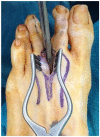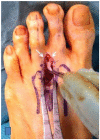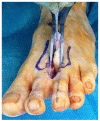Morton's interdigital neuroma: instructional review
- PMID: 30800476
- PMCID: PMC6362341
- DOI: 10.1302/2058-5241.4.180025
Morton's interdigital neuroma: instructional review
Abstract
The terminology 'Morton's neuroma' may represent a simplification of the clinical condition as the problem may not be a benign tumour of the nerve, but neuropathic foot pain associated with the interdigital nerve.Foot and ankle pathomechanics leading to metatarsalgia, clinical examination and differential diagnosis of the condition and imaging of the condition, for differential diagnosis, are discussed.Nonoperative management is recommended initially. Physiotherapy, injections (local anaesthetic, steroid, alcohol), cryotherapy, radiofrequency ablation and shockwave therapy are discussed.Operative treatment is indicated after nonoperative management has failed. Neuroma excision has been reported to have good to excellent results in 80% of patients, but gastrocnemius release and osteotomies should be considered so as to address concomitant problems.Key factors in the success of surgery are correct diagnosis with recognition of all elements of the problem and optimal surgical technique. Cite this article: EFORT Open Rev 2019;4:14-24. DOI: 10.1302/2058-5241.4.180025.
Keywords: Morton’s neuroma; interdigital nerve; metatarsalgia.
Conflict of interest statement
ICMJE Conflict of interest statement: N. Gougoulias and A. Sakellariou declare travel/accommodation/meeting expenses from EFAS, activity outside the submitted work.
Figures

















References
-
- Morscher E, Ulrich J, Dick W. Morton’s intermetatarsal neuroma: morphology and histological substrate. Foot Ankle Int 2000;21:558–562. - PubMed
-
- Morton TG. A peculiar and painful affection of the fourth metatarso-phalangeal articulation. Am J Med Sci 1876;71:37–45.
-
- Di Caprio F, Meringolo R, Eddine MS, Ponziani L. Morton’s interdigital neuroma of the foot: a literature review. Foot Ankle Surg 2017;24:92–98. - PubMed
-
- Singh D. Nils Silfverskiöld (1888–1957) and gastrocnemius contracture. Foot Ankle Surg 2013;19:135–138. - PubMed
-
- Owens R, Gougoulias N, Guthrie H, Sakellariou A. Morton’s neuroma: clinical testing and imaging in 76 feet, compared to a control group. Foot Ankle Surg 2011;17:197–200. - PubMed
LinkOut - more resources
Full Text Sources
Other Literature Sources

